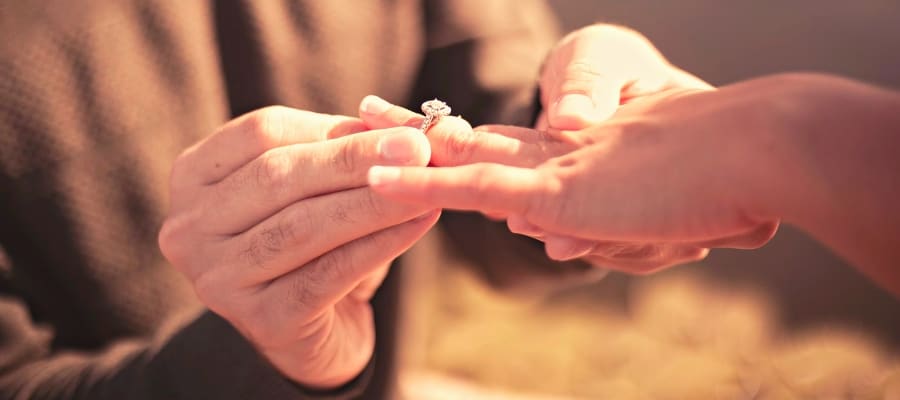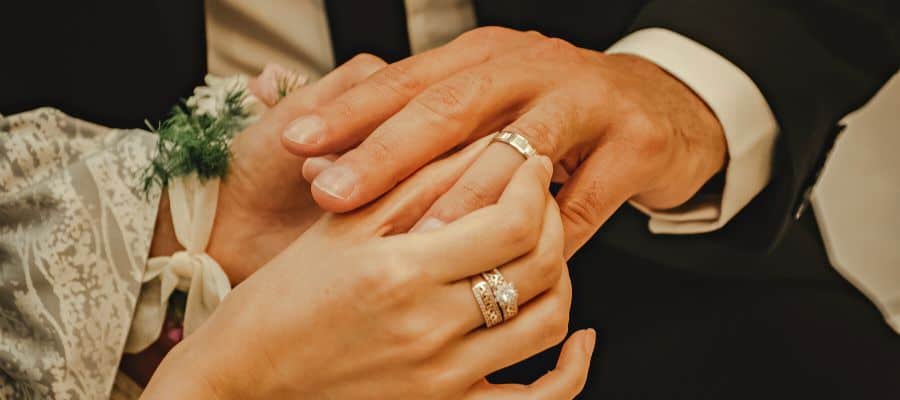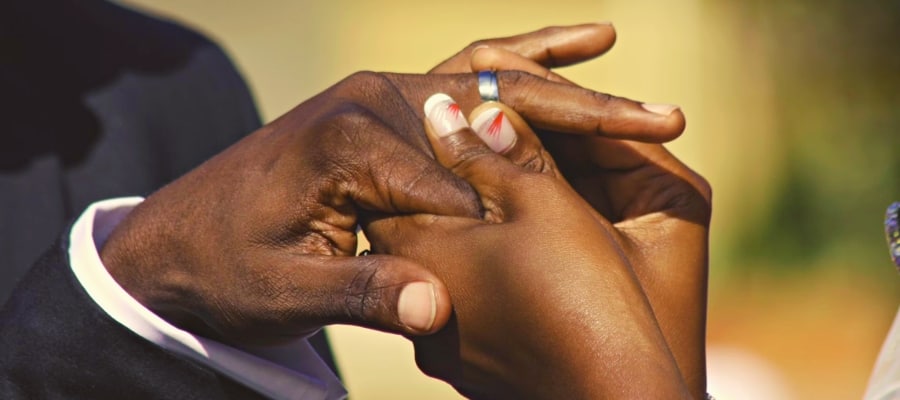When a man proposes marriage to a woman, he buys her an engagement ring, but he doesn’t usually get one in return. Although he and his wife will exchange wedding bands on their wedding day, he doesn’t wear a ring to signify that he’s engaged. Why don’t guys wear engagement rings?
Guys don’t wear engagement rings because historically and traditionally, they’re a symbol of a man’s ownership of a woman. Although some modern men wear engagement rings, this practice still isn’t widely observed today due to this historical influence.
In this article, I’ll explore why guys don’t wear engagement rings. I’ll also look at some attempts to make male engagement rings popular and how many modern men who get engaged choose to wear engagement rings.
The Historical Reasons Many Modern Men Don’t Wear Engagement Rings

Engagement rings date all the way back to the 2nd century. During this time, grooms would give their brides rings when they got engaged and at special events.
The rings were made of gold, but women were also given rings made of iron that they were supposed to wear at home. Both of these rings were symbolic of the man’s ownership of the woman.
Puzzle Rings in Asia
The idea of ownership of women by men was rife during the first century BC when puzzle rings were used in Asia. These rings were popular gifts from sheiks and sultans, who would use them as a way to “tag” their wives.
Puzzle rings were made up of multiple rings that fit together to create a band, and this complex design was meant to monitor a woman’s behavior. If a woman removed the ring, such as if she was being unfaithful to her husband, she’d be unable to put it back together, which would indicate to her husband that she had betrayed him.
Engagement Ring as a Hold on a Woman’s Virginity
The history of engagement rings is quite controversial. Men would give women engagement rings as a way to ensure their virginity. The engagement ring would indicate that the virginal woman was “on hold” until she got married, and the entire marriage was a transaction between the two parties.
Engagement Ring as Compensation for Breaking an Engagement
One of the biggest problems with engagement rings was that if the man changed his mind about the woman, he had the power to damage her reputation and cause her to be considered damaged goods by society.
So, until 1945, a law called the “Breach of Promise to Marry” gave women a chance to sue men for breaking off their engagement, and they would hold onto the engagement ring as a type of insurance to keep him around.
The women also stood to gain compensation from the ring if the man changed his mind about marrying them, which was significant because women couldn’t buy a property and didn’t have much of their own money.
In the U.S., many states repealed these laws by 1935. A consequence of this decision was that expensive engagement rings became more popular, with the idea that they would serve as financial security for women.
It’s clear to see that although engagement rings have been designed to display romantic love and are usually advertised in this way (think of the 1938 De Beers ad campaign “A diamond is forever” that associated diamonds with love), this wasn’t always the case.
Here are some important highlights of engagement rings and their history of being worn by women instead of men:
- Engagement rings signified ownership. The tradition of engagement rings was established in Roman times when wives would wear rings attached to small keys, which were a display of them being owned by their husbands. A man basically held the key to a woman as though she were his property.
- Engagement rings were about the male intention to marry. Their significance hails back to the year 850 when engagement rings were given official meaning by Pope Nicholas I, who announced that this piece of jewelry was a symbol of a man’s intention to marry a woman. These rings were symbolic of a business contract but were sometimes used to represent mutual love and obedience between a couple.
- Diamond engagement rings became popular for women in 1477. The Archduke Maximilian of Austria commissioned a diamond engagement ring for his bride, Mary of Burgundy. This started the trend of engagement rings for women which is still popular. While ideas of an engagement ring being a sign of a woman belonging to a man are outdated, it’s still not common for men to wear engagement rings.
Why Modern Men Don’t Wear Engagement Rings

Jewelry historians claim that there are some common reasons why modern men don’t wear engagement rings. These include the following:
- Men don’t wear or buy jewelry as much as women. This is why they don’t wear engagement rings. Although this is changing, a study found that 78% of women make jewelry purchases on the premium shopping app Lyst and buy three times more jewelry than men.
- Men usually propose marriage. The engagement ring is a symbol of an engagement proposal. Although more women are proposing marriage to men, 97% of grooms propose to their partners.
- Conventional ideas of a man’s ability to provide for a woman are still present. An engagement ring indicates the man’s ability to be able to provide for his bride. In line with this view, it’s thought that engagement rings need to be worth three months’ salary. On average, though, Americans spend about 4% (or two weeks) of their annual pre-tax income on engagement rings.
The Rise (and Fail) of “Man-Gagement” Rings

Although engagement rings have traditionally been seen as a woman’s piece of jewelry, especially because of how they represent a man’s ownership of a woman, there’s evidence of male engagement rings in history.
The Gimmel Rings
For example, gimmel rings were popular in 1525. These rings consisted of two or three hoops that were joined together to create one ring. The term “tie the knot” is thought to have originated as a result of gimmel rings.
When a man and woman would get engaged, both of them would wear one part of the gimmel ring until the day of their wedding. On this day, the hoops of the ring would be put back together to create one ring that the bride would wear.
Couples such as Martin Luther and Catherine Bora chose to wear gimmel rings when they tied the knot in 1525.
Masculine Engagement Rings
Back in 1926, jewelers attempted to establish engagement rings for men to purchase and wear. They even ran advertising campaigns to make the idea of men wearing engagement rings more popular.
At the time, Macy’s, a department store that used to be known as L. Bamberger & Co., ran newspaper advertisements that tried to make male engagement rings look masculine and cool so that they would be appealing to men.
Some of the ads featured a man’s hand displaying cigarettes and large diamond rings, and to further appeal to men, the rings had names such as “Master” and “Pilot”.
Despite these attempts, the rings didn’t become popular. Engagement rings were still considered feminine, and this was greatly influenced by how ring designs were becoming more elaborate.
For example, in the early 1900s, popular diamonds that were used in engagement rings consisted of the old European cut diamond that was a delicate round stone. On the other hand, in the 1920s art deco era, rings became more elaborate, with a blend of diamonds and colorful gemstones.
The Popularity of Male Engagement Rings Today

There have been more recent attempts to make male engagement rings more popular. In the 2000s, a jewelry designer from Great Britain is said to have designed an engagement ring made of titanium that had small diamonds in it, which was meant to be marketed for men. It did help to encourage more men to want to wear engagement rings.
Currently, there have been some changes to the perceptions and ideas surrounding engagement rings, with an increased interest in men wanting to wear engagement rings.
Some male celebrities, such as Ed Sheeran and Michael Bublé, have been spotted wearing engagement rings, but “man-gagement” rings are by no means a trend.
According to a survey conducted by XO Group Inc, only five percent of men who are engaged wear rings. And, a study in 2019 found that 6% of men who are in heterosexual relationships wear engagement rings. By comparison, 49% of men in same-sex couples exchange rings.
Cultures in Which Men Wear Engagement Rings
Although male engagement rings aren’t very popular in the U.S., in some countries and regions, men do wear engagement rings, and the practice of doing so is much more common.
- Chile. In Chile, it’s customary for men to wear engagement rings on the right ring finger instead of the left, which is considered the traditional ring finger. Then, when they get married, they move the ring onto the right hand. Some men choose to wear their engagement rings on a necklace instead of wearing an engagement ring on their hands.
- Argentina. In this country, male engagement rings are popular. They’re traditionally made of silver, while wedding rings are gold.
- Nordic countries. In many Nordic countries, such as Iceland, both women and men exchange and wear their engagement rings. These rings are usually made out of a gold band. In Sweden, while both men and women wear engagement rings when they get married, the bride will add a second ring while the groom won’t.
- Eastern Europe. In countries such as Russia and Poland, both grooms and brides wear engagement rings, and they tend to wear them on their right ring finger, which is where they also wear their wedding rings.
- Turkey. In this country, there’s a unique engagement ring tradition that involves the groom and bride receiving engagement rings that are tied together with a ribbon. At the couple’s engagement, a senior family member cuts the ribbon and delivers wishes to the couple before giving them rings to wear.
Men’s Engagement Ring: What Choices There Are

Although one might assume that male engagement rings aren’t highly decorative, there are different styles of rings from which to choose. Let’s explore the different elements to consider when choosing a male engagement ring or purchasing one for your partner.
Materials
There’s a range of materials that can be used in the design of male engagement rings, such as:
- Silicone
- Cobalt
- Rose gold
- Yellow gold
- White gold
- Wood
- Titanium
Type of Ring Bands
There are various engagement ring band designs, from simple bands in a metal or material of your choice all the way to bands that contain multiple diamonds, depending on the man’s preference. Depending on the material, ring bands can also come in different colors to suit the man’s taste.
Ring Fit
There are various fits that are available, such as the standard fit. This fit is when there’s a flat surface underneath the ring. Another type of fit is the comfort fit, which is when there’s a rounded surface beneath the ring.
Ring Size
Since a man’s finger is usually wider than a woman’s finger, a male engagement ring will be wider. Some of the most common ring sizes for men are:
- 4 mm (0.16 in)
- 6 mm (0.24 in)
- 8 mm (0.31 in)
Promise Ring as an Alternative to Engagement Ring for Men

Engagement rings are typically given to symbolize the certainty of a couple’s intention to marry. On the other hand, promise rings can be worn by a couple at any stage of their relationship.
Either way, the promise ring bands symbolize monogamous relationships and that the couple is exclusively dating. They’re also a subtle reminder that the couple intends to take their relationship further.
A promise ring is a suitable alternative to an engagement ring for men because it usually comes in a simple design almost similar to a wedding band.
Promise rings are worn by both the man and the woman. Although they usually appear similar, one can be customized with elaborate designs to resemble an engagement ring for a woman. On the other hand, the couple can decide if they want to customize the man’s promise ring.
Final Thoughts
Engagement rings are usually given to women and men don’t wear engagement rings. While some men would wear gimmel rings during the 1500s, engagement rings were historically a symbol of a man’s ownership of a woman. That’s why they weren’t popular among men.
Although engagement rings aren’t traditionally a piece of jewelry that men wear, these days, they are slowly growing in popularity, with more men choosing to wear them. Still, this is a matter of preference.


